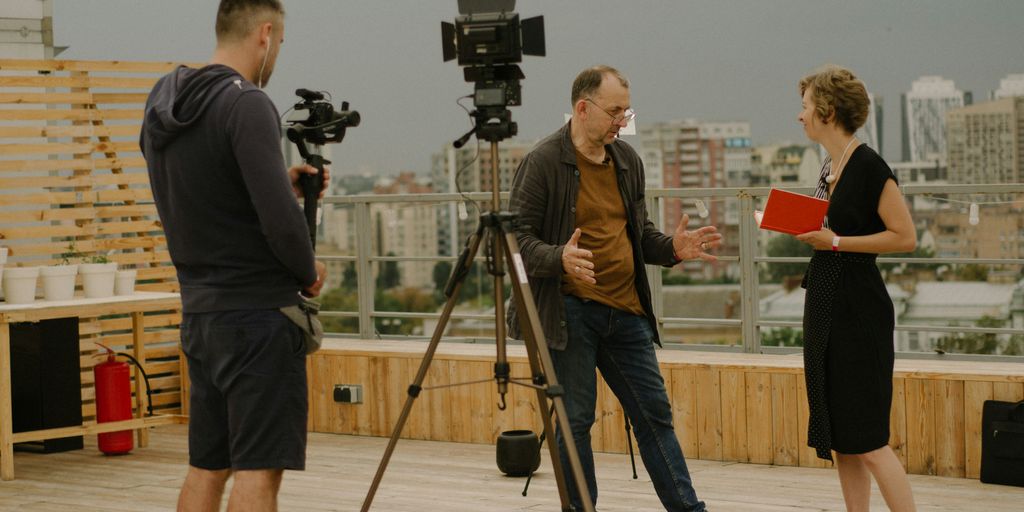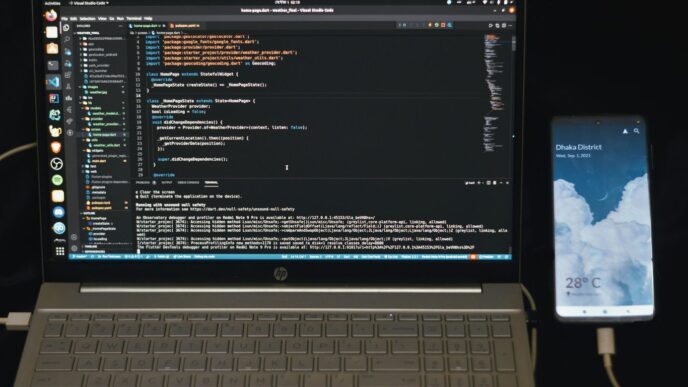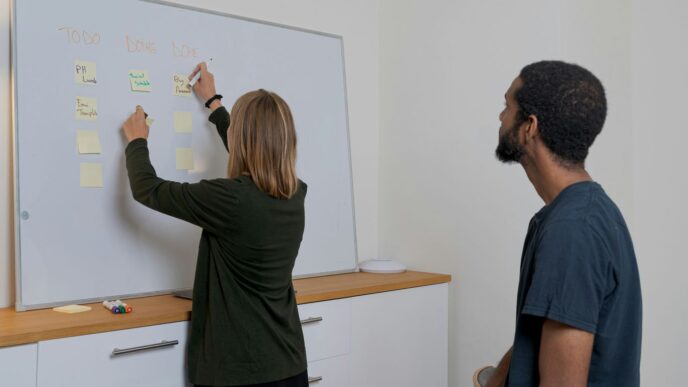So, you aced the first interview, huh? Nice job! But don’t kick back just yet. The second round is a whole different ballgame. This is where companies really dig in to see if you’re the right fit, not just on paper, but in person. It’s your chance to show them what you’re really about and why you’re the one they should pick. We’re going to talk about how to handle those tricky second round interview questions, making sure you leave a great impression and get that job offer.
Key Takeaways
- Do your homework on the company and the job. Know what they’re all about.
- Think back to your first interview. What could you have done better? Fix it for this one.
- Practice answering common second round interview questions. Have your answers ready.
- Use the STAR method for behavioral questions. It helps keep your answers clear.
- Ask smart questions. Show them you’re interested and you’ve been paying attention.
Nailing Your Second Interview
So, you made it to the second interview! Congrats! This is where things get a little more serious. It’s not just about repeating what’s on your resume; it’s about showing them you really get the company and the role. Let’s break down how to make a killer impression.
Strategies for Success in a Second Interview
The second interview is your chance to really solidify your fit. Think of it as building on the foundation you laid in the first round. It’s about demonstrating that you’ve not only heard what they’re saying, but you’ve also thought deeply about it. Here’s how:
- Dig Deeper: Don’t just rehash your first interview answers. Expand on them, show growth in your understanding of the role. If they mentioned a specific project, research it further and come prepared with informed questions.
- Connect the Dots: Explicitly link your skills and experiences to the company’s needs. Don’t assume they’ll make the connection themselves. Spell it out: "Based on our last conversation about [project name], my experience with [relevant skill] would allow me to contribute to [specific goal]."
- Be Ready for Anything: Second interviews often involve more behavioral questions and hypothetical scenarios. Practice using the STAR method (Situation, Task, Action, Result) to structure your answers. This helps you provide clear, concise, and compelling stories.
Researching the Company and Role
Okay, you did some research before the first interview, right? Now it’s time to go next level. This isn’t just about knowing the company’s mission statement; it’s about understanding their challenges, their opportunities, and their place in the market. Effective leadership is key here.
- News & Trends: Read industry publications, follow the company’s social media, and set up Google Alerts to stay informed about their latest news and announcements. This shows you’re genuinely interested and proactive.
- Competitor Analysis: Understand who their main competitors are and how the company differentiates itself. This demonstrates strategic thinking and a broader understanding of the business landscape.
- Employee Reviews: Check out sites like Glassdoor to get insights into the company culture and employee experiences. This can help you formulate insightful questions and assess whether the company is a good fit for you.
Reviewing Your First Interview Performance
Think back to your first interview. What went well? What could you have done better? This is your chance to address any shortcomings and reinforce your strengths. Don’t be afraid to be honest with yourself.
- Identify Weak Spots: Did you stumble on a particular question? Did you fail to adequately highlight a key skill? Make a list of areas where you could improve.
- Practice, Practice, Practice: Rehearse your answers to common interview questions, focusing on the areas where you struggled in the first interview. Record yourself and analyze your performance.
- Seek Feedback: Ask a friend, mentor, or career counselor to conduct a mock interview and provide constructive criticism. A fresh perspective can help you identify blind spots and refine your approach.
Mastering Second Round Interview Questions
Okay, so you made it to the second interview! Congrats! Now comes the part where you really need to show them what you’ve got. The first interview was about getting your foot in the door, but this one is about proving you’re the right fit. This section will cover how to handle those more in-depth questions and really impress the interviewers.
Common Second Interview Questions and How to Answer Them
Second interviews often dig deeper. They want to know how you think, how you handle pressure, and how well you’ll fit into the team. Expect questions like:
- Tell me about a time you failed. What did you learn?
- Describe your ideal work environment.
- What are your salary expectations?
When answering, be honest, be specific, and always tie it back to how your experience benefits the company. Don’t just say you’re a hard worker; give an example of a time you went above and beyond. Think about how to avoid common job interview mistakes.
Impressing Your Interviewer with Your Second Interview Responses
It’s not just about what you say, but how you say it. Here are a few tips:
- Be confident: Even if you’re nervous, project confidence in your abilities.
- Be enthusiastic: Show that you’re genuinely excited about the opportunity.
- Be yourself: Don’t try to be someone you’re not. Authenticity goes a long way.
Showcasing Your Expertise and Potential Fit
This is your chance to really shine. Highlight your skills and experience, but also show them how you’ll fit into their company culture. Do your research and understand their values. Demonstrate that you’re not just looking for a job, but a place where you can grow and contribute. Think about how your executive leadership skills can be an asset to the company.
Common Second Interview Questions You Should Prepare For
Articulating Your Motivation for the Role
Okay, so you made it to the second interview! That’s awesome, but now they really want to know why you want this job. It’s not enough to just say you need a paycheck. They’re digging for genuine enthusiasm and a clear understanding of what the company does and how you fit in. Think about it: have you researched their recent projects? Do you know their mission statement? Can you explain how your skills directly contribute to their goals? If not, get on it! You need a solid answer that shows you’re not just looking for any job, but this job.
Discussing Your Strengths and Areas for Development
This is the classic
Crafting Effective Responses to Behavioral Questions
Utilizing the STAR Method for Structured Answers
Okay, so behavioral questions are a big deal in second interviews. They’re basically asking you to tell stories about your past experiences. The interviewer wants to know how you actually behave in certain situations, not just how you think you’d behave. That’s where the STAR method comes in super handy. It’s a framework for structuring your answers so they’re clear, concise, and compelling. STAR stands for Situation, Task, Action, and Result.
- Situation: Set the scene. Briefly describe the context of the story. Where were you? Who was involved? What was going on?
- Task: Explain what your responsibility was in that situation. What were you trying to achieve?
- Action: Detail the specific steps you took to address the situation. What did you do? Be specific and avoid vague statements.
- Result: Describe the outcome of your actions. What was the impact? What did you learn? Quantify the results if possible.
Using the STAR method helps you stay focused and provide all the necessary information without rambling. It’s like a roadmap for your answer, guiding the interviewer through your thought process and demonstrating your problem-solving skills. It’s a great way to tackle those behavioral interview questions.
Highlighting Problem-Solving Abilities and Resilience
Interviewers aren’t just looking for people who can follow instructions; they want problem-solvers. They want to see that you can think on your feet, overcome obstacles, and learn from your mistakes. When answering behavioral questions, make sure to highlight your problem-solving abilities and resilience.
- Identify the Problem: Clearly articulate the challenge you faced. What were the obstacles preventing you from achieving your goal?
- Describe Your Approach: Explain how you analyzed the problem and developed a solution. What steps did you take to address the challenge?
- Showcase Your Resourcefulness: Did you need to learn new skills, seek advice from others, or find creative solutions? Highlight your ability to adapt and overcome obstacles.
- Emphasize Your Resilience: Even if the outcome wasn’t perfect, focus on what you learned from the experience. How did you bounce back from setbacks? What would you do differently next time?
Providing Specific Examples of Your Skills
One of the biggest mistakes you can make in a second interview is being too vague. Interviewers want to see concrete evidence of your skills and abilities. That means providing specific examples from your past experiences. Don’t just say you’re a good communicator; tell a story about a time when you used your communication skills to resolve a conflict or persuade a client.
- Quantify Your Results: Whenever possible, use numbers to demonstrate the impact of your actions. For example, instead of saying you "increased sales," say you "increased sales by 15% in the first quarter."
- Focus on Your Contributions: Make sure to highlight your specific role in the situation. What did you do to contribute to the outcome?
- Tailor Your Examples: Choose examples that are relevant to the job you’re applying for. Think about the skills and qualities the employer is looking for and select stories that showcase those attributes.
- Be Authentic: Don’t try to fabricate stories or exaggerate your accomplishments. Be honest and genuine in your responses. Interviewers can usually spot a fake, and it will hurt your credibility.
Engaging Interviewers with Insightful Questions
Formulating Questions to Assess Company Alignment
Okay, so you’ve made it to the second interview. Congrats! Now’s your chance to really dig in and see if this company is a good fit for you. Don’t just sit there waiting to be grilled. Come prepared with questions that show you’re thinking about the bigger picture. For example, instead of asking about vacation time right away, try asking about the company’s long-term goals and how the role you’re interviewing for contributes to those goals. This shows you’re interested in more than just a paycheck.
Demonstrating Genuine Interest in the Organization
It’s not enough to just ask questions; you need to show that you’ve actually done your homework. Generic questions like "What does your company do?" are a big no-no. Instead, ask about recent company news, initiatives, or challenges. Show that you’ve taken the time to understand their business. For instance, if they just launched a new product, ask about the strategy behind it or the initial customer response. This demonstrates genuine interest and initiative, which is always a plus.
Understanding the Role’s Nuances and Culture
Beyond the company itself, you want to get a feel for the day-to-day realities of the role and the team dynamics. Ask about a typical workday or week. What are the biggest challenges the team is currently facing? What opportunities are there for professional development? Understanding the role’s nuances will help you determine if it’s a good fit for your skills and career goals. Don’t be afraid to ask about the company culture, too. Is it collaborative or more individualistic? What are the opportunities for social interaction? These are important factors to consider when making your decision.
Here’s a quick list of question categories to consider:
- Company Strategy: Questions about long-term goals, market position, and competitive advantages.
- Team Dynamics: Questions about team structure, communication styles, and collaboration methods.
- Role Expectations: Questions about daily tasks, performance metrics, and opportunities for growth.
- Company Culture: Questions about values, work-life balance, and social activities.
Post-Interview Professionalism
Sending a Timely Thank-You Email
Okay, so you’ve just finished your second interview. You’re probably feeling a mix of relief and anxiety. But the process isn’t over yet! Sending a thank-you email is super important. Aim to send it within 24 hours of your interview. It shows you’re polite and serious about the job. It’s a small thing that can really make a difference. I know it sounds old-fashioned, but trust me, it still matters. It’s like saying ‘thanks for your time’ and subtly reminding them you’re keen on the job. Plus, it keeps you fresh in their minds.
Personalizing Your Follow-Up Message
Don’t just send a generic thank-you note. That’s a waste of time. Make it personal! Mention something specific you talked about during the interview. Did you discuss a project? A particular skill? Bring it up! It shows you were actually listening and engaged. It also gives you another chance to highlight why you’re a good fit. For example, you could say, "I especially enjoyed discussing [specific project] and how my experience in [relevant skill] could contribute to your team’s success." See? Way better than just saying "Thanks for the interview!" This is a great way to show your suitability for the role.
Maintaining Professionalism Throughout the Process
Even after the interview and thank-you email, keep it professional. If they gave you a timeline for when they’ll make a decision, wait until then before following up. And when you do follow up, be polite and concise. No need to be pushy or demanding. A simple "I’m checking in on the status of the position" is enough. Also, be mindful of your online presence. Hiring managers might check your social media. Make sure everything is appropriate. Remember, you’re always representing yourself, even when you think no one’s watching. It’s all about making a good impression, from start to finish.
Elevating Your Candidacy in the Second Round

Reaffirming Your Suitability for the Position
So, you made it to the second interview! Congrats! Now’s the time to really drive home why you’re the best fit. Don’t just rehash your resume; instead, connect your past experiences directly to the specific needs of the role. Think of it as painting a picture of you already succeeding in the job. For example, if they need someone who can manage a team through a crisis, talk about a time you did just that, highlighting the positive outcomes and what you learned. It’s about showing, not just telling.
Showcasing Compatibility with Team and Values
Companies aren’t just looking for skills; they want someone who gels with the team and embodies their values. Do your homework! What’s their mission statement? What do they emphasize in their marketing? Use this knowledge to demonstrate how your work style and personal values align with theirs. Maybe they value innovation – share a time you came up with a creative solution. Or perhaps they prioritize collaboration – describe a successful team project where you played a key role. This is where you show that you understand the company culture and can thrive within it. Remember that second interview is a great opportunity to show your personality.
Making Informed Decisions About Your Future Career
The second interview isn’t just about them evaluating you; it’s also about you evaluating them. Come prepared with insightful questions that show you’re seriously considering this opportunity. Ask about the team’s dynamics, the company’s long-term goals, or the challenges the role faces. This demonstrates your engagement and helps you determine if this is truly the right fit for your career aspirations. Don’t be afraid to ask the tough questions – it shows you’re not just looking for any job, but the right job.
Here are some questions you might consider:
- What are the biggest challenges the team is currently facing?
- How does the company support professional development?
- What are the key performance indicators (KPIs) for this role?
Wrapping It Up
So, there you have it. Getting through that second interview really comes down to doing your homework, thinking through your answers, and just being yourself. If you put in the effort to show what you can do, and how excited you are about the job, you’re definitely upping your chances. Good luck out there!
Frequently Asked Questions
What does a second interview mean?
A second interview means you did great in the first one! It’s a chance for the company to get to know you better and see if you’re a good fit for their team and how they work.
How can I do well in a second interview?
To do well, you should learn more about the company, think about your first interview, and be ready to talk about your skills and what you can bring to the job.
What kind of questions will they ask in a second interview?
They might ask about a time you solved a tough problem, what you’re good at and what you need to improve, or how you work with others.
How should I answer questions about my past experiences?
When answering, tell a story using the STAR method: explain the Situation, the Task you had, the Action you took, and the Result. This helps show your skills clearly.
Should I ask questions during the second interview?
Yes, you should definitely ask questions! It shows you’re really interested. Ask things that help you understand the job, the team, and the company better.
What should I do after the second interview?
Always send a thank-you note soon after the interview. Make it special for each person you talked to. If you don’t hear back when they said you would, it’s okay to send a polite follow-up message.














